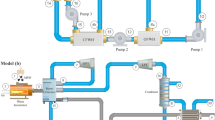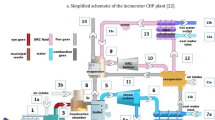Abstract
This paper attempts to present a fundamental system analysis for the performances of currently operating waste-to-energy incinerators in Tokyo special ward district. Firstly, it is stated that the gross thermal efficiency η G of any steam turbine generation system could be expressed as a product of four parameters: the boiler efficiency η b, turbine steam utilization fraction R t, heat cycle constant R h, and turbine generator chamber efficiency η tg. Secondly, reliable heat inputs to waste-to-energy systems were established by the ideal boiler efficiencies η b,ids which are based on the versatility of the standardized combustion gas properties, to avoid totally depending on the conventional low calorific value measurements of the fed-waste which occasionally include dubious results. Thirdly, the achievement of technological progress of power generation in waste-to-energy systems over the past 3 decades was reviewed. The advantage of 4 MPa class incinerators (installed after 2001) over 3 MPa class incinerators (installed before 1999) in η G by 33.1% on average was clarified. Fourthly, the difference in operational modes which affects the η G was studied to seek for the optimum operation in terms of energy recovery. In conclusion, this paper evaluated that the overall η G of the 20 incinerators in FY2015 proved to be 15.0%.






Similar content being viewed by others
Abbreviations
- Comp i :
-
Weighted average of n mass percentages of i constituent of fed-waste (%kg/kg−w) Eq. (9)
- C ji :
-
Mass percentage of i constituent of fed-waste at j incinerator (%kg/kg−w)
- c :
-
Energy unit conversion factor (c ≡ 3.6 × 106 J/kWh)
- cE :
-
Heat equivalent of power generation (J)
- c p :
-
Constant-pressure specific heat of combustion gas \(({\text{kJ}}/({\text{m}}_{\text{N}}^{3} \;{\text{K}}))\)
- \(\bar{c}_{\text{p}}\) :
-
Mean constant-pressure specific heat of the standardized combustion gas \(({\text{kJ}}/({\text{m}}_{\text{N}}^{3} \;{\text{K}}))\)
- E :
-
Power generation (kWh)
- E u :
-
Power generation per ton of waste (kWh/t−w)
- G 0 :
-
Amount of theoretical combustion gas per unit mass of waste (\({\text{m}}_{\text{N}}^{3} /{\text{kg}}_{{ - {\text{w}}}}\))
- G(λ):
-
Amount of SCG per unit mass of waste (\({\text{m}}_{\text{N}}^{3} /{\text{kg}}_{{ - {\text{w}}}}\)) Eq. (11)
- \(\bar{H}\) :
-
The mean LCV of fed-waste (J/kg−w) (\(\bar{H}\) ≡ Q w/W)
- H j :
-
Annual LCV measurement at j incinerator (J/kg−w)
- H j *:
-
Estimated annual mean LCV of fed-waste at j incinerator (J/kg−w) Eq. (15)
- H ω :
-
The LCV of the waste of representative composition (J/kg−w) Eq. (10)
- H ω *:
-
Estimated annual overall mean LCV of fed-waste (J/kg−w) Eq. (16)
- h X :
-
Specific enthalpy at condensate return tank outlet (J/kg)
- h Y :
-
Specific enthalpy at boiler feeding pump outlet (J/kg)
- h Z :
-
Specific enthalpy at superheater outlet (J/kg)
- L 0 :
-
Amount of theoretical air per unit mass of waste (\({\text{m}}_{\text{N}}^{3} /{\text{kg}}_{{ - {\text{w}}}}\))
- l boiler :
-
Boiler heat losses (J)
- l other :
-
Heat losses except boiler heat losses (J)
- M :
-
Amount of turbine entering steam over a period for examination (kg)
- M 0 :
-
Amount of steam evaporation over a period for examination (kg)
- \(\dot{m}\) :
-
Mass flow rate of turbine entering steam (kg/s)
- \(\dot{m}_{0}\) :
-
Evaporation rate (kg/s)
- n :
-
Number of operating incinerators in a period for examination
- \(\dot{n}\) :
-
Mass flow rate of extracted steam (kg/s)
- P :
-
Power output (kW)
- P r :
-
Rated power output (kW)
- Q b :
-
Heat absorbed by boiler (J) (Q b ≡ M 0 (h Z-h Y))
- Q C :
-
Circulating heat (J)
- Q E :
-
External heat supply quantity (J)
- Q g :
-
Combustion heat of auxiliary fuel (city gas) (J)
- Q I :
-
Heat input to the WtE system (J) Eq. (1)
- Q S :
-
Vaporization heat (J)
- Q t :
-
Heat supplied to steam turbine (J) (Q t ≡ M (h Z-h X))
- Q w :
-
Combustion heat of fed-waste (J)
- q :
-
Volumetric fraction of water vapor over unit dry combustion air when absolute humidity of air is taken into account
- R E :
-
External heat supply fraction Eq. (5)
- R h :
-
Heat cycle constant Eq. (7)
- R t :
-
Turbine steam utilization fraction Eq. (6)
- r :
-
Correction factor representing minor heat losses between ideal and actual boiler heat absorptions
- W :
-
Amount of waste incineration (kg−w)
- η b :
-
Boiler efficiency Eq. (2)
- η b,id :
-
Ideal boiler efficiency Eq. (14)
- η G :
- η tg :
-
Turbine generator chamber efficiency Eq. (4)
- θ :
-
Temperature of combustion gas (°C)
- θ a :
-
Adiabatic theoretical temperature of combustion gas (°C) Eqs. (12) and (13)
- θ b,o :
-
Flue gas temperature at the boiler outlet (°C)
- θ 0 :
-
Standard reference temperature (°C) (θ 0 = 25 °C)
- θ ∞ :
-
Surrounding temperature (°C)
- λ :
-
Excess air ratio
- ρ j *:
-
Fraction of auxiliary fuel heat over waste heat at j incinerator ρ j * ≡ Q g,j /(H j *W J )
- τ :
-
Period for examination (s), (D)
- ψ :
-
Generator load factor (ψ ≡ P/P r)
- ω j :
-
Waste incineration fraction of j incinerator over the total amount of annual waste incineration (ω j ≡ W j /ΣW j ) (j = 1,2,…,n)
- Subscript j :
-
When added, subscript j denotes that the symbol is related to j incinerator
References
The World Bank (1999) Municipal solid waste incineration. World Bank Technical Guidance Report
Der Budesminister des Innern (1982) Bericht der Bundesrepublik Deutshland zur Umweltpolitik
Rae CW (1994) Recovering energy from waste: emissions and their control. In: Hester RE, Harrison RM (eds) Waste incineration and environment. The Royal Society of Chemistry, Cambridge, pp 53–69
Furubayasi M, Tsuji K, Takuma M, Yamada A, Kurita M, Nishino M (2015) Foreign waste incinerator using combustion technology for improving power generation (in Japanese). Haikibutsu Gakkaishi 26(2):120–129
Shino Y (2016) Most probable LCV of the combustible MSW incinerated in 23 cities area of Tokyo (in Japanese). Seisou Gihou (Technical Report of Public Cleansing) 16:98–108
Ministry of Environment (2016–17) Ippan haikibutu no haishutsu oyobi shori joukyou tou ni tsuite (Status of Discharge and Treatment of MSW) in 2014–15 (in Japanese) Official announcement report
Clean Authority of TOKYO (2014–15) Fed-waste survey at incineration plants and other facilities (in Japanese)
Clean Authority of TOKYO (2014–15) Annual operation report of incineration plants and other facilities (in Japanese)
Clean Authority of TOKYO (2014–15) Commissioned survey report on flue gas analysis at incineration plant and other facilities (in Japanese)
Shino Y (2017) Mean LCV evaluation of treated MSW utilizing the versatility of the standardized combustion gas (in Japanese). Seisou Gihou 17:91–100
Shino Y (2016) Evaluation of energy recovery technology applied to MSW incineration (in Japanese). Seisou Gihou 16:109–119
Shino Y (2015) Properties of standardized combustion gas in incineration of combustible MSW (in Japanese). Seisou Gihou 15:125–134
Shino Y (2017) Analysis of WtE system based on the four parameters of gross thermal efficiency (in Japanese). Seisou Gihou 17:101–114
World Energy Council (2016) World Energy Resources Waste to Energy 2016
Shino Y (2015) Annual heat balance concerning MSW incinerators in Tokyo special ward district (in Japanese). Seisou Gihou 15:115–124
Author information
Authors and Affiliations
Corresponding author
Rights and permissions
About this article
Cite this article
Shino, Y. Analytical study of power generation efficiency of WtE systems operating in Tokyo special ward district. J Mater Cycles Waste Manag 20, 632–644 (2018). https://doi.org/10.1007/s10163-017-0632-2
Received:
Accepted:
Published:
Issue Date:
DOI: https://doi.org/10.1007/s10163-017-0632-2




